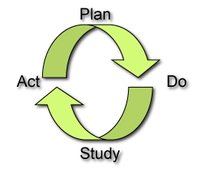 | ||||
| PDSA cycle |
We had some good discussion about the different approaches and gave each group feedback. I showed the class a video resource that I had found on milking a goat -so we could have some discussion about its effectiveness and how a resource like this can be used in a lesson like the one we planned. This particular video was good because it showed the milking technique close up and the process and rationale was explained well. I also showed an example of other resources that could be used in a lesson plan. Milk a goat by hand - pictures and instructions. People thought these would be useful for students as they can be studied more slowly than a video. I also suggested using web resources.
Effectiveness of using video resources
We discussed that it is best to pause video if it is used and have discussion part way through. It is also good to provide questions for students to think about prior to watching the video, and probably questions to reflect on afterwards. I talked about the video resource as useful for providing a concrete experience if using Kolb's experiential learning cycle - it is not always possible or necessary to see a 'live demo' or have an actual experience until the skill has been demonstrated using some form of media. So concrete experience can be about feeling, viewing or doing.
 |
| http://academic.regis.edu/ed202/subsequent/kolb2.htm |
See what you think of these resources and what else you can find.
- Using Video in Teaching and Learning - this article gives some good pointers about using video resources. Although considered effective, video can cause challenges as it depends on how it is used. It can become a passive medium unless activities are included. What do they suggest?
- Instructional video in e-learning: Assessing the impact of interactive video on learning effectiveness - article on Moodle. The authors found that video is only effective for learning when it is interactive. Why? It to do with how video encourages constructivist learning or cognitive processing of information. So how can a video resource be made interactive?
- It is not television anymore: Designing digital video for learning and assessment by Daniel Schwartz and Kevin Hartman from Stanford University. They discuss the concept of 'designed video' and "provide a simple framework for mapping uses of video into desired and observable learning outcomes". From their perspective the use of and design of video needs to be planned if it is to be effective for learning. See what you think.



